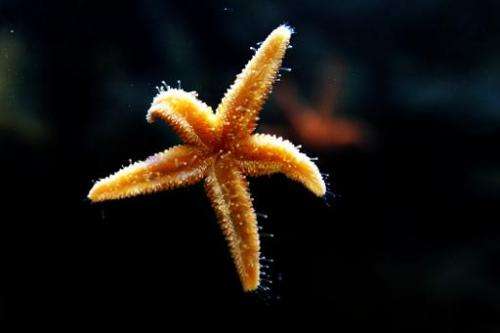Mass sea star deaths off US west coast puzzle scientists

Starfish have been mysteriously dying by the millions in recent months along the US west coast, worrying biologists who say the sea creatures are key to the marine ecosystem.
Scientists first started noticing the mass deaths in June 2013. Different types of starfish, also known as sea stars, were affected, from wild ones along the coast to those in captivity, according to Jonathan Sleeman, director of the US Geological Survey's National Wildlife Health Center.
"The two species affected most are Pisaster ochraceus (purple sea star or ochre starfish) and Pycnopodia helianthoides (sunflower sea star)," he wrote in a statement in December.
The sunflower sea star is considered among the largest starfish and can span more than a meter in diameter.
The most commonly observed symptoms are white lesions on the arms of the sea star. The lesions spread rapidly, resulting in the loss of the arm. Within days, the infection consumes the creature's entire body, and it dies.
Entire populations have been wiped out in Puget Sound off the coast of Washington state, in the Salish Sea off Canada's British Columbia as well as along the coast of California. The mortality rate is estimated at 95 percent.
Scientists who have spent decades studying the local ecosystem have yet to identify the cause.
"What we currently think is likely happening is that there is a pathogen, like a parasite or a virus or a bacteria, that is infecting the sea stars and that compromises in some way their immune system," Pete Raimondi, chair of the department of ecology and evolutionary biology, at the University of California, Santa Cruz, told AFP.
Then, the creatures become more susceptible to bacteria which is "causing a secondary infection that causes most of the damages that you see."
A barometer of sea health
The 2013 phenomenon has not been observed solely along the West Coast; a smaller outbreak also killed East Coast sea stars last year.
Previous cases were believed to be associated with warmer waters—sea stars have sensitive skin and prefer cooler water—but this was not the case in 2013.
And when the die-offs happened previously, the geographic span of the infections was much smaller, and far fewer sea stars were affected.
In 1983, an epidemic nearly wiped out the Pisaster ochraceus from tidal pools along the southern coast of California.
Another, smaller die-off in 1997 may have been caused by warmer waters in an El Nino year, scientists said.
Sea stars are important because "they play a key role in this ecosystem on the West Coast," Raimondi said.
Sea stars eat mussels, barnacles, snails, mollusks and other smaller sea life, so their health is considered a measure of marine life on the whole in a given area.
When sea stars decline in number, "the mussel population has the potential to dramatically increase, which could significantly alter the rocky intertidal zone," according to Sleeman.
While sea stars make up an important component of the base of the ocean food chain and are considered a top predator, they are in turn eaten by other starfish, shorebirds, gulls, and sometimes sea otters.
In an effort to find out what is causing the mass deaths, scientists are collecting reports from the public, taking specimens to the lab for analysis and doing genetic sequencing to find out whether a toxin or an infection may be to blame.
© 2014 AFP


















